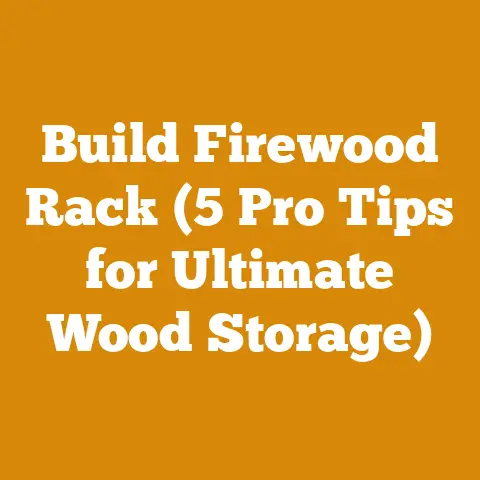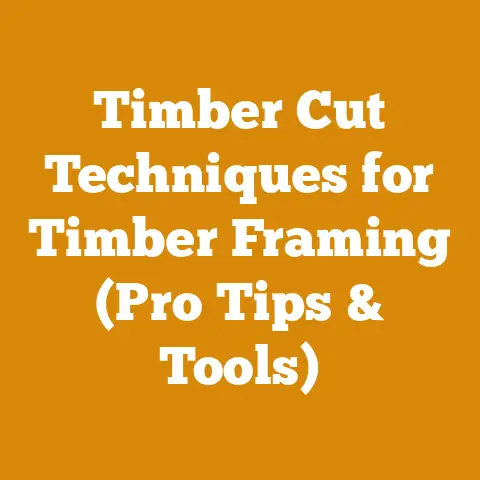Flatbed Firewood Haulers Showcase (Rugged DIY Builds & Mods)
The opportunity to efficiently move and manage firewood is often overlooked, yet it’s a critical factor in both personal comfort and the profitability of small-scale firewood businesses. Many of us, myself included, start with a wheelbarrow and a strong back. But as demand grows or age creeps in, the need for a more efficient solution becomes clear. That’s where the idea of a DIY flatbed firewood hauler comes in. It’s not just about moving wood; it’s about optimizing your workflow, reducing strain, and maximizing the value of your time.
This article dives deep into the world of DIY flatbed firewood haulers. I’ll share my experiences, insights, and practical guides to help you design and build a hauler that perfectly suits your needs. Whether you’re a seasoned welder looking for a challenging project or a novice DIYer eager to improve your firewood game, this guide has something for you.
Flatbed Firewood Haulers Showcase (Rugged DIY Builds & Mods)
Let’s explore the possibilities of building your own rugged flatbed firewood hauler, focusing on DIY builds and modifications. This journey will cover everything from initial design considerations to the final touches that make your hauler a personalized workhorse.
Understanding the Need: Why a DIY Flatbed Hauler?
Before diving into construction, it’s important to understand why a DIY flatbed hauler is a worthwhile investment. Commercially available options often fall short in customization and affordability. A DIY approach allows you to tailor the hauler to your specific needs, budget, and available resources.
Consider these benefits:
- Customization: Design a hauler that fits your specific vehicle (ATV, UTV, tractor) and the size of your firewood.
- Cost Savings: Building your own can be significantly cheaper than buying a pre-made model, especially if you have access to used materials.
- Durability: You control the quality of materials and construction, ensuring a robust and long-lasting hauler.
- Personal Satisfaction: There’s a unique sense of accomplishment in building something yourself.
My Experience: I remember the days of hauling firewood in my old pickup truck, constantly battling back pain and wasted space. Building my first flatbed trailer for my ATV was a game-changer. Suddenly, I could move twice the amount of wood with half the effort. The customization allowed me to perfectly match the trailer to the width of my wood stacks, maximizing efficiency.
Key Considerations Before You Start Building
Before you even pick up a welding torch or saw, there are crucial decisions to make. These will dictate the success and utility of your flatbed hauler.
- Load Capacity: How much firewood do you realistically need to haul at once? This will determine the size and strength of your frame, axle, and tires. A good rule of thumb is to overestimate slightly. Firewood is heavier than you think, especially when green.
- Vehicle Compatibility: What vehicle will be pulling the hauler? An ATV requires a smaller, lighter hauler than a tractor. Ensure your vehicle has the towing capacity and appropriate hitch.
- Terrain: Will you be hauling wood over smooth, paved surfaces or rough, uneven terrain? This will influence your choice of tires, suspension (if any), and ground clearance.
- Budget: Be realistic about your budget. Factor in the cost of steel, wheels, axles, welding supplies, paint, and any other necessary components. Don’t forget to account for potential cost overruns.
- Skill Level: Assess your welding and fabrication skills. If you’re a beginner, start with a simpler design and consider taking a welding course.
- Materials: Consider using reclaimed steel or other materials to reduce cost. Keep an eye out for old trailers or equipment that can be repurposed.
Data Point: According to a study by the American Society of Agricultural and Biological Engineers, the average weight of seasoned hardwood firewood is approximately 35 pounds per cubic foot. Green wood can weigh significantly more, sometimes exceeding 50 pounds per cubic foot. This highlights the importance of accurately estimating your load capacity.
Designing Your Flatbed Firewood Hauler: Step-by-Step
The design phase is critical. A well-thought-out design will save you time, money, and frustration during the build process.
Step 1: Sketching and Measuring
Start with a rough sketch of your desired hauler. Include dimensions for the bed size, overall length, and hitch height. Take precise measurements of your vehicle’s hitch and any relevant dimensions of your wood stacks.
Example:
- Bed Size: 4ft wide x 8ft long (suitable for standard firewood lengths)
- Overall Length: 12ft (including tongue)
- Hitch Height: 18 inches (common for ATVs and UTVs)
Step 2: Frame Design
The frame is the backbone of your hauler. Use strong, durable steel, such as 2×4 inch rectangular tubing or 3×3 inch angle iron. Design the frame with cross members for added strength and support. Consider a ladder-frame design for simplicity and ease of welding.
Tips:
- Use a CAD program or online trailer design tool to create a detailed drawing. This will help you visualize the final product and identify potential problems.
- Ensure all welds are strong and properly penetrated. Poor welds are a common cause of trailer failure.
- Consider adding gussets to reinforce high-stress areas, such as the corners and hitch connection.
Step 3: Axle and Suspension
The axle is responsible for supporting the weight of the load. Choose an axle with a weight rating that exceeds your planned load capacity. Leaf spring suspension can provide a smoother ride, especially on rough terrain. However, a simple torsion axle is a cost-effective alternative for lighter loads and smoother surfaces.
Axle Selection Guide:
- Light Duty (up to 1000 lbs): 1-inch solid steel axle
- Medium Duty (1000-2000 lbs): 1.5-inch solid steel axle or a light-duty torsion axle
- Heavy Duty (2000+ lbs): 2-inch solid steel axle or a heavy-duty torsion axle with leaf springs
Step 4: Wheels and Tires
Select wheels and tires that are appropriate for the load capacity and terrain. Consider using used tires from a car or truck to save money. Ensure the tires have sufficient tread and are in good condition.
Tire Considerations:
- Load Rating: Ensure the tires have a load rating that meets or exceeds the axle’s weight capacity.
- Tire Size: Choose a tire size that provides adequate ground clearance and stability.
- Tire Type: Consider using all-terrain tires for better traction on uneven surfaces.
Step 5: Hitch and Tongue
The hitch connects the hauler to your vehicle. Use a commercially available hitch coupler that is compatible with your vehicle’s hitch ball. The tongue should be long enough to provide adequate clearance between the hauler and your vehicle during turns.
Hitch Recommendations:
- Ball Size: Match the hitch ball size to the coupler size (typically 2 inches or 2 5/16 inches).
- Safety Chains: Always use safety chains to secure the hauler to your vehicle in case of hitch failure.
- Breakaway Switch: Consider installing a breakaway switch if your hauler is equipped with brakes.
Step 6: Bed Design
Bed Material Options:
Building Your Flatbed Firewood Hauler: A Practical Guide
Now that you have a design, it’s time to start building. This section provides a step-by-step guide to constructing your flatbed hauler.
Step 1: Gathering Materials and Tools
Before you start, gather all the necessary materials and tools. This will save you time and prevent frustration during the build process.
Materials List (Example):
- Welding machine
- Angle grinder with cutting and grinding discs
- Measuring tape
- Square
- Level
- Drill with various drill bits
- Wrenches and sockets
- Hammer
- Clamps
- Safety glasses
- Welding helmet
- Gloves
Step 2: Cutting and Preparing the Steel
Cut the steel tubing or angle iron to the required lengths according to your design. Use an angle grinder with a cutting disc or a metal-cutting saw. Deburr the edges of the cut steel to prevent sharp edges.
Safety Tip: Always wear safety glasses and gloves when working with steel.
Step 3: Welding the Frame
Weld the steel pieces together to form the frame. Ensure the frame is square and level. Use clamps to hold the pieces in place while welding. Start with tack welds to secure the pieces, then complete the welds.
Welding Techniques:
- Tack Welding: Small, intermittent welds used to hold pieces in place.
- Full Penetration Welding: Welds that penetrate the entire thickness of the steel for maximum strength.
- Fillet Welding: Welds used to join two pieces of steel at an angle.
Step 4: Installing the Axle
Position the axle under the frame and weld it in place. Ensure the axle is centered and square to the frame. If using leaf spring suspension, install the spring hangers and shackles before welding the axle.
Axle Placement:
- Measure the distance from the front of the frame to the axle. This distance should be equal on both sides.
- Use a level to ensure the axle is perpendicular to the frame.
Step 5: Mounting the Wheels and Tires
Install the wheels and tires on the hubs. Tighten the lug nuts to the manufacturer’s specifications. Check the tire pressure and adjust as needed.
Tire Pressure:
- Consult the tire manufacturer’s recommendations for the appropriate tire pressure.
- Overinflating or underinflating tires can affect handling and tire wear.
Step 6: Attaching the Hitch and Tongue
Weld the hitch coupler to the tongue. Ensure the hitch is aligned with the frame and is at the correct height. Attach the safety chains to the tongue.
Hitch Alignment:
- Use a level to ensure the hitch is level with the frame.
- Measure the distance from the hitch to the front of the frame. This distance should be consistent.
Step 7: Building the Bed
Cut the bed material to the required size and shape. Attach the bed to the frame using screws, bolts, or welds. Consider adding side rails to prevent firewood from falling off.
Bed Attachment:
- Use screws or bolts for easy removal and replacement.
- Weld the bed to the frame for a more permanent and durable attachment.
Step 8: Finishing Touches
Grind down any rough welds and sharp edges. Apply primer and paint to protect the steel from rust and corrosion. Install any additional accessories, such as lights, reflectors, or a spare tire carrier.
Painting and Finishing:
- Use a rust-resistant primer to prevent corrosion.
- Apply multiple coats of paint for a durable and attractive finish.
Modifications and Customizations: Taking It to the Next Level
Once you have a basic flatbed hauler, you can customize it to meet your specific needs. Here are some ideas for modifications and customizations:
- Removable Sides: Add removable sides to increase the hauling capacity and prevent firewood from falling off.
- Tilt Bed: Install a hydraulic or manual tilt mechanism to make unloading firewood easier.
- Ramps: Add ramps to make loading and unloading firewood with a wheelbarrow or hand truck easier.
- Tool Storage: Incorporate a tool storage compartment to keep your chainsaw, axe, and other tools readily accessible.
- Log Bunks: Install log bunks to make hauling long logs easier.
- Lights and Reflectors: Add lights and reflectors to improve visibility when hauling firewood at night.
My Modification Story: I added a hand-operated winch to my flatbed hauler. This allowed me to easily load large logs onto the trailer without having to lift them manually. It significantly reduced the strain on my back and made the process much more efficient.
Safety Considerations: Working with Firewood and Trailers
Safety is paramount when working with firewood and trailers. Here are some important safety considerations:
- Wear appropriate personal protective equipment (PPE), including safety glasses, gloves, and steel-toed boots.
- Use caution when lifting heavy objects. Lift with your legs, not your back.
- Secure the load properly. Use straps or chains to prevent firewood from shifting during transport.
- Drive safely and obey all traffic laws.
- Inspect your trailer regularly. Check the tires, axles, hitch, and lights.
- Never exceed the trailer’s weight capacity.
- Be aware of your surroundings. Watch out for pedestrians, vehicles, and obstacles.
- Use caution when operating power tools. Follow the manufacturer’s instructions and wear appropriate PPE.
Statistical Insight: According to the National Fire Protection Association (NFPA), approximately 24,000 residential fires are caused by heating equipment each year. Proper firewood storage and handling can help reduce the risk of fire. Store firewood away from your home and other structures, and keep the area around your wood stove or fireplace clear of flammable materials.
Wood Selection and Preparation: Maximizing Efficiency
The type of wood you use and how you prepare it can significantly impact the efficiency of your firewood operation.
Green Wood vs. Seasoned Wood:
- Green Wood: Freshly cut wood that contains a high moisture content. It is difficult to burn and produces a lot of smoke.
- Seasoned Wood: Wood that has been allowed to dry for several months. It burns more easily and produces less smoke.
Seasoning Process:
- Split the Wood: Splitting the wood exposes more surface area to the air, speeding up the drying process.
- Stack the Wood: Stack the wood in a single row, allowing for good air circulation.
- Elevate the Wood: Elevate the wood off the ground using pallets or skids to prevent moisture from wicking up.
- Cover the Wood: Cover the top of the wood pile with a tarp to protect it from rain and snow.
Wood Types:
- Hardwoods: Dense woods that burn hotter and longer than softwoods. Examples include oak, maple, and ash.
- Softwoods: Less dense woods that burn quickly and produce more smoke. Examples include pine, fir, and spruce.
Strategic Advantage: Using seasoned hardwood firewood will provide more heat and burn more efficiently than green softwood. This translates to fewer trips to the wood pile and more efficient heating.
Chainsaws:
- Gas-Powered Chainsaws: Powerful and portable, but require more maintenance.
- Electric Chainsaws: Quieter and easier to maintain, but less powerful and require a power outlet.
- Cordless Chainsaws: Offer a good balance of power and portability, but battery life can be limited.
Axe:
- Splitting Axe: Designed for splitting firewood.
- Felling Axe: Designed for felling trees.
- Maul: A heavy axe with a wedge-shaped head, used for splitting large logs.
Log Splitters:
- Hydraulic Log Splitters: Powerful and efficient, but expensive.
- Manual Log Splitters: Less expensive, but require more physical effort.
- Gas-Powered Log Splitters: Offer a good balance of power and portability.
- Electric Log Splitters: Quieter and easier to maintain, but less powerful and require a power outlet.
Tool Specifications:
- Chainsaw Bar Length: Choose a bar length that is appropriate for the size of the logs you will be cutting.
- Axe Weight: Choose an axe weight that you can comfortably swing for extended periods.
- Log Splitter Tonnage: Choose a log splitter with a tonnage rating that is sufficient for the size of the logs you will be splitting.
Benefits of Using a Hydraulic Splitter: A hydraulic log splitter can significantly increase your efficiency and reduce the physical strain of splitting firewood. It allows you to split large logs quickly and easily, saving you time and energy.
Stacking Firewood: Maximizing Space and Airflow
Properly stacking firewood is essential for efficient drying and storage.
Stacking Methods:
- Crisscross Stacking: Stacking the wood in a crisscross pattern provides good air circulation and stability.
- Holz Hausen: A circular stack that allows for good air circulation and protects the wood from the elements.
- Linear Stacking: Stacking the wood in a straight line, which is simple and efficient.
Stacking Tips:
- Stack the wood off the ground.
- Allow for good air circulation.
- Cover the top of the stack with a tarp.
- Stack the wood in a sunny location.
- Keep the stack away from your home and other structures.
Original Insight: I’ve found that using old pallets as a base for my firewood stacks not only elevates the wood but also allows for excellent airflow underneath, significantly reducing drying time.
Cost Analysis: DIY vs. Buying
Before embarking on your DIY flatbed hauler project, it’s helpful to compare the cost of building your own versus buying a commercially available model.
DIY Cost Breakdown (Example):
- Steel: $200
- Axle: $150
- Wheels and Tires: $100
- Hitch Coupler: $50
- Bed Material: $100
- Welding Supplies: $50
- Paint: $20
- Total: $670
Commercially Available Flatbed Hauler Cost: $1000 – $2000+
Factors to Consider:
- Labor: Your time is valuable. Factor in the time it will take you to design and build the hauler.
- Tools: Do you already own the necessary tools, or will you need to purchase them?
- Materials: Can you source used or reclaimed materials to reduce costs?
- Customization: How much value do you place on having a hauler that is tailored to your specific needs?
Strategic Advantage: Building your own flatbed hauler can save you a significant amount of money, especially if you have access to used materials and tools. However, it requires time, skill, and effort.
Drying Times: Planning for the Future
Understanding drying times is essential for ensuring you have a steady supply of seasoned firewood.
Drying Time Factors:
- Wood Type: Hardwoods take longer to dry than softwoods.
- Climate: Warm, dry climates are ideal for drying firewood.
- Stacking Method: Proper stacking can significantly reduce drying time.
- Splitting: Splitting the wood exposes more surface area to the air, speeding up the drying process.
Estimated Drying Times:
- Softwoods: 6-12 months
- Hardwoods: 12-24 months
Planning Ahead: It’s important to plan ahead and start drying your firewood well in advance of the heating season. This will ensure you have a supply of seasoned wood that is ready to burn when you need it.
Next Steps: Implementing Your Project
Ready to start building your own flatbed firewood hauler? Here are some practical next steps:
- Finalize Your Design: Create a detailed drawing of your hauler, including dimensions and material specifications.
- Gather Your Materials and Tools: Make a list of the necessary materials and tools and start sourcing them.
- Clear a Workspace: Designate a safe and well-ventilated workspace for welding and fabrication.
- Start Building: Follow the step-by-step guide outlined in this article.
- Test and Refine: Once you’ve completed the build, test the hauler and make any necessary adjustments.
Remember, building a flatbed firewood hauler is a rewarding project that can save you time, money, and effort in the long run. With careful planning, attention to detail, and a commitment to safety, you can create a durable and efficient hauler that will serve you well for years to come. Good luck, and happy hauling!






